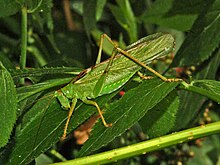Tettigonia viridissima, the great green bush-cricket,[1] is a large species of bush-cricket belonging to the subfamily Tettigoniinae.[2]
| Great green bush-cricket | |
|---|---|

| |
| T. viridissima, male | |
| Scientific classification | |
| Domain: | Eukaryota |
| Kingdom: | Animalia |
| Phylum: | Arthropoda |
| Class: | Insecta |
| Order: | Orthoptera |
| Suborder: | Ensifera |
| Family: | Tettigoniidae |
| Subfamily: | Tettigoniinae |
| Tribe: | Tettigoniini |
| Genus: | Tettigonia |
| Species: | T. viridissima
|
| Binomial name | |
| Tettigonia viridissima | |
| Synonyms | |
| |
Distribution and habitat
editThis species can be encountered in most of Europe, in the eastern Palearctic realm, in the Near East, and in North Africa,[3] especially in meadows, grasslands, prairies and occasionally in gardens at an elevation up to 1,800 metres (5,900 ft) above sea level.[4]
Description
editThe adult males grow up to 28–36 millimetres (1.1–1.4 in) long, while females reach 32–42 millimetres (1.3–1.7 in).[4] This insect is most often completely green (but there are specimens completely yellowish or with yellow legs), excluding a rust-colored band on top of the body.[4] The organ of the stridulation of the males is generally brown.
Tettigonia viridissima is distinguished by its very long and thin antennae, which can sometimes reach up to three times the length of the body, thus differentiating them from grasshoppers, which always carry short antennae. It could be confused with Tettigonia cantans, whose wings are a centimeter shorter than the ovipositor, or Tettigonia caudata, whose hind femurs bear conspicuous black spines.
The morphology of both sexes is very similar, but the female has an egg-laying organ (ovipositor) that can reach a length of 23–32 millimetres (0.91–1.26 in). It reaches the end of the elytra and is slightly curved downward.[5]
The larvae are green and as the imago show a thin brown longitudinal stripe on their back. The ovipositor can be seen from the fifth stage; the wings appear in both genders from the sixth stage.
Biology
editTettigonia viridissima is carnivorous and arboreal. Its diet is mostly composed of flies, caterpillars and larvae.[4] Unlike grasshoppers, it is essentially active in day and night, as testified by its endless crepuscular and nocturnal singing.[4] The species can bite painfully but is not particularly aggressive. It is best to avoid holding the insect in the fist, as that almost guarantees a bite. They can fly, but they tend to avoid flying where possible. Most often they move "on foot" or jumps, which allow them to travel about in bushes and trees.
Gallery
edit-
Males can be recognized by the absence of the ovipositor
-
Females can be recognized by the ovipositor
-
Nymph on Phleum pratense
-
Anatomy of the head
-
Mandibles
-
Hearing bubble on the forelimb
-
Close-Up of a Tettigonia viridissima
-
Female during ecdysis (molting)
References
edit- ^ Ragge DR (1965). Grasshoppers, Crickets & Cockroaches of the British Isles. F Warne & Co, London. p. 299.
- ^ Catalogue of life
- ^ Fauna europaea
- ^ a b c d e INPN
- ^ Michael Chinery, Insectes de France et d'Europe occidentale, Flammarion, 320 p. (ISBN 978-2-0812-8823-2), p. 50-51 (in French)
External links
edit- Data related to Tettigonia viridissima at Wikispecies
- Media related to Tettigonia viridissima at Wikimedia Commons
- Video of Tettigonia viridissima in a tree
- Insectes-net
- Tettigonia viridissima
- Green grasshopper eating a butterfly